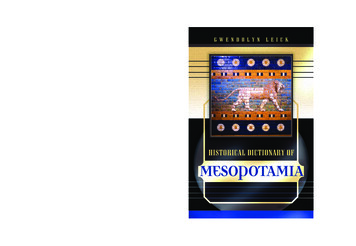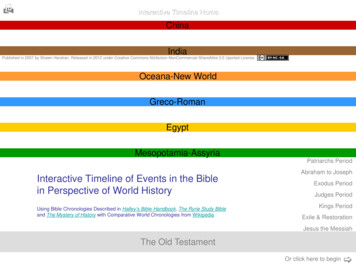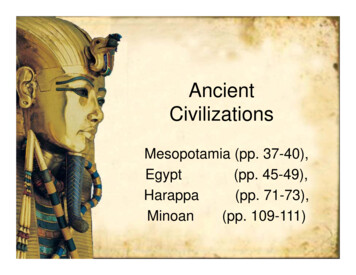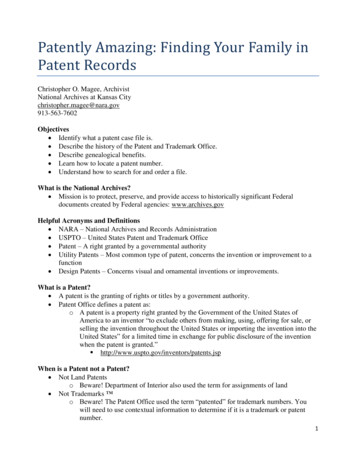
Transcription
Historical Dictionaries of Ancient Civilizations and Historical Eras, No. 9MG W E N D O L Y N L E I C K is senior lecturer at the Chelsea College of Artand Design in London. She is the author of Mesopotamia: The Inventionof the City and The Babylonians: An Introduction.For orders and information please contact the publisherScarecrow Press, Inc.A wholly owned subsidiary ofThe Rowman & Littlefield Publishing Group, Inc.4501 Forbes Boulevard, Suite 200Lanham, Maryland 207061-800-462-6420 fax 717-794-3803www.scarecrowpress.comCover photograph: Molded and glazed brick striding lion from the Processional Way, Babylon,Neo-Bablonian Period, ca. 604-562 B.C., courtesy of the Oriental Institute.MESOPOTAMIAHistorical Dictionary of Mesopotamia provides a ready reference aboutthe history of a civilization for which there are many gaps in the data.The many city-states; kingdoms and empires; the famous and lesserknown rulers; the arts of war and the arts of peace; and the interestingaspects of everyday life such as food and drink, religion, clothing andjewelry, housing, family relationships—including marriage and evendivorce—and other social relations are all covered. Professors andstudents of history, archeology, and social sciences, as well asresearchers who need a reference about the era, will find thisdictionary to be a wealth of information about the people and eventsthat shaped this ancient civilization’s history.GWENDOLYN LEICKHISTORICAL DICTIONARY OFesopotamia, the land between the Tigris and Euphratesrivers, was one of the greatest cradles of civilization. Forseveral millennia, it was the site of major city-states, kingdoms, and empires that fought and gradually replaced oneanother, including Akkad, Ur, Babylon, the Kassites, and Assyria, inthe earlier periods; followed by the Achaemenid, Seleucid,Parthian, and Sassanian dynasties. The arts of war were indispensablefor survival, but the arts of peace were also practiced in the developmentof agriculture, metalworking and trade, the organization of anadministration and bureaucracy, the emergence of religions, and thedevelopment of a more sophisticated state structure.LEICKHistory AncientHISTORICAL DICTIONARY OFMESOPOTAMIA
Historical Dictionaries of Ancient Civilizationsand Historical ErasSeries editor: Jon Woronoff1.2.3.4.5.6.7.8.9.Ancient Egypt, Morris L. Bierbrier, 1999.Ancient Mesoamerica, Joel W. Palka, 2000.Pre-Colonial Africa, Robert O. Collins, 2001.Byzantium, John H. Rosser, 2001.Medieval Russia, Lawrence N. Langer, 2001.Napoleonic Era, George F. Nafziger, 2001.Ottoman Empire, Selcuk Aksin Somel, 2003.Mongol World Empire, Paul D. Buell, 2003.Mesopotamia, Gwendolyn Leick, 2003.
Historical Dictionaryof MesopotamiaGwendolyn LeickHistorical Dictionaries of AncientCivilizations and Historical Eras, No. 9The Scarecrow Press, Inc.Lanham, Maryland, and Oxford2003
SCARECROW PRESS, INC.Published in the United States of Americaby Scarecrow Press, Inc.A Member of the Rowman & Littlefield Publishing Group4501 Forbes Boulevard, Suite 200, Lanham, MD 20706www.scarecrowpress.comPO Box 317OxfordOX2 9RU, UKCopyright 2003 by Gwendolyn LeickAll rights reserved. No part of this publication may be reproduced,stored in a retrieval system, or transmitted in any form or by anymeans, electronic, mechanical, photocopying, recording, or otherwise,without the prior permission of the publisher.British Library Cataloguing in Publication Information AvailableLibrary of Congress Cataloging-in-Publication DataLeick, Gwendolyn, 1951Historical dictionary of Mesopotamia / Gwendolyn Leick.p. cm. — (Historical dictionaries of ancient civilizations andhistorical eras ; no. 9)Includes bibliographical references.ISBN 0-8108-4649-71. Iraq–History–To 634–Dictionaries. I. Title. II. Series.DS70.82.L45 2003935'.003–dc212003000835 The paper used in this publication meets the minimum requirements ofAmerican National Standard for Information Sciences—Permanence ofPaper for Printed Library Materials, ANSI/NISO Z39.48-1992.Manufactured in the United States of America.
ContentsEditor’s Foreword Jon WoronoffviiConventionsixMap of MesopotamiaxChronologyxiiiIntroductionxvTHE DICTIONARY1Appendix I. Mesopotamian Rulers139Appendix II. Museums149Select Bibliography155About the Author187v
Editor’s ForewordMesopotamia was one of the oldest and broadest cradles of civilization.Unlike Egypt, which was a relatively unified state, it was the site of manydifferent city-states, kingdoms, and empires, frequently at odds with oneanother, and replacing one another as the locus of power—Akkad, Ur,Babylon, the Kassites, Isin, Assyria—and then tending into the more “modern” Achaemenid, Seleucid, Parthian, and Sassanian Dynasties. The transfer of power resulted from a superior capacity in warfare, not so differentfrom our times, and the rise of great leaders such as Sargon of Akkad, Hammurabi, Nebuchadrezzar, Darius, and Alexander the Great. All the while,the Mesopotamians also are known to have been practicing the arts ofpeace; developing agriculture, metalworking, and trade; devising forms ofwriting; constructing monumental buildings; organizing an administrationand bureaucracy; worshipping various gods; laying down laws; and determining who was higher and who was lower in society. Not so different fromour times. That is why Mesopotamia remains so intriguing, showing wherewe came from and part of how we got where we are, and maybe even giving us some insight into where we’re heading.The message would obviously be much clearer if, like Egypt, there hadbeen a relatively unified state rather than many statelets that tended to wipeaway earlier traces left by predecessors, and if the sands of time—and thedesert—had not covered over so many of their remains. Thus, what wehave been able to uncover, and do know with a reasonable degree of certainty, is particularly precious. So it is nice to have much of it presented ina handy form by the Historical Dictionary of Mesopotamia.The dictionary section helps us sort out the many city-states, kingdoms,and empires; the famous and less well-known rulers (some far from glorious); the arts of war and the arts of peace; the signs of a maturing civilization and high culture; plus aspects of everyday life, including food anddrink, clothing and jewelry, housing and cities, social relations and the formation of families, marriage, and even divorce. The whole time frame is toovii
viii EDITOR’S FOREWORDcomplicated for a straightforward chronology, but the periods are located inthe chronology and the rulers in Appendix I. The bibliography is very helpful in suggesting in some detail where further readings can be found.Writing this book, with its myriad periods and aspects, was no easy task.But it was certainly easier for someone, Gwendolyn Leick, who has alreadywritten several books on the ancient Near East, its architecture, literature,and mythology, as well as a “who’s who” and an introduction to the Babylonians. Dr. Leick has spent nearly three decades studying, lecturing on,and writing about Mesopotamia. She has also taught at the universities ofGlamorgan, Cardiff, Reading, and in London City, and is a fellow of theRoyal Anthropological Institute. This long and varied experience is the basis for the latest volume in the steadily growing series of Historical Dictionaries of Ancient Civilizations and Historical Eras.Jon WoronoffSeries Editor
ConventionsThe pronunciation of ancient names is a modern reconstruction and a convention rather than an accurate phonetic rendering. Although cuneiformwriting indicated vowels (unlike ancient Egyptian), it is not clear how theywere spoken at any given period. Consonants were sometimes written inseveral different ways, hard or soft, which indicates that there were phonetic variations (e.g., Hammurapi as well as Hammurabi). Sumerian mayhave had nasal sounds, but this is not clearly indicated in writing.Conventionally, the vowels of Sumerian and Akkadian words are pronounced as in German, partly as a result of the pioneering work of Germanscholars in cuneiform lexicography and grammar. The letter a is thereforeas in far, e as in very, i as in is, o as in core, and u as in full. Diphthongs arenot in evidence, and two successive vowels, as in Eanna, should be pronounced separately, as in theater. Akkadian, as a Semitic language, had anumber of guttural sounds, such as the ‘ayin, the qof, and the throaty h, andseveral sibilants (sade, sin, and shin), as well as dental t (tet). These are notindicated as such in this volume, except for š in Akkadian words, which isrendered as sh in transcribed names. The accent is generally on the penultimate syllable.The names, order, and dates of ancient rulers are not fixed, due to gapsin the transmission, damages on the surface of tablets, and insufficient datafor some periods. Dates in the dictionary follow the “middle chronology.”The use of boldface type serves as a cross-reference to other entries inthe text.ix
ChronologyPREHISTORIC PERIODSMiddle paleolithicc. 78.000–28.000 B.C.Upper paleolithicc. 28.000–10.000Neolithicc. 10.000–6000Chalcolithicc. 6000–3000Hassunac. 5500–5000Halaf / Ubaidc. 5000–4000Urukc. 4000–3200Jemdet-Nasrc. 3200–3000HISTORICAL PERIODSSouthern Mesopotamia:Early Dynastic Ic. 3000–2750Early Dynastic IIc. 2750–2600Early Dynastic IIIc. 2600–2350Dynasty of Akkadc. 2350–2150Third Dynasty of Urc. 2150–2000xiii
xiv CHRONOLOGYOld Babylonian periodc. 2000–1600Isin-Larsa Dynastiesc. 2000–1800First Dynasty of Babylonc. 1800–1600Kassite Dynastyc. 1600–1155Second Dynasty of Isinc. 1155–1027Second Dynasty of Sealandc. 1026–1006Dynasty of E979–732Assyrian domination732–626Neo-Babylonian Dynasty626–539Northern Mesopotamia:Old Assyrian period1900–1400Middle Assyrian period1400–1050Neo-Assyrian period Empire934–610Achaemenid Empire539–331Seleucid Dynasty311–126Parthian period126–227 A.D.Sassanian period224–642 A.D.Islamic periodSince 642
IntroductionThe Greek name Mesopotamia means “land between the rivers.” The Romans used this term for an area that they controlled only briefly (between115 and 117 A.D.)—the land between the rivers Euphrates and Tigris, fromthe south Anatolian Mountains ranges to the Persian Gulf. In modern usagethe geographical definition is the same, but the historical context is widerand reaches much further back than the period of the Romans. It comprisesthe civilizations of Sumer and Akkad (third millennium B.C.) as well as thelater Babylonian and Assyrian empires of the second and first millennium.Although the “history” of Mesopotamia in the strict sense of the term onlybegins with the inscriptions of Sumerian rulers around the 27th century B.C.,the foundations for Mesopotamian civilization, especially the beginnings ofirrigation and the emergence of large permanent settlements, were laid muchearlier, in the fifth and fourth millennium. Archaeological research is themain source for these prehistoric periods, but it also plays a very importantpart in the process of understanding and interpreting later periods, complementing the written evidence.The key element in the development of Mesopotamian cultures was thegradual adaptation to the ecological conditions of the region. The originalhomeland for Stone Age man was the Levantine coast. The first experimentsin cultivating cereals and domesticating animals had occurred in this morenaturally fertile region, which received a higher amount of annual rainfall. Inthe Neolithic period (c. 10,000–6,000 B.C.), other areas in the lee of mountainridges, in Syria and Anatolia, became inhabited, and the first densely occupied settlements with permanent architecture appeared as a gradual shift tookplace from hunting and gathering as the main form of subsistence to morespecialized forms of life, either agriculture or nomadic pastoralism. NorthernMesopotamia (between the south Anatolian Mountain ridge and the latitudeof present-day Baghdad) was situated in the geographical zone in which rainfall agriculture was possible. The earliest Mesopotamian settlements, datingback to the sixth millennium, were found here. Excavations at sites such asxv
xvi INTRODUCTIONTell Brak, Tell Arpachiya, Tepe Gawra, and Nineveh have yielded plentifulpolychrome painted pottery and sometimes substantial buildings.In contrast, the alluvial plains of the south lie in one the driest andhottest regions of the world, neighboring the great deserts of Syria andnorthern Arabia. The oldest archaeological sites there date from the fifthmillennium and were concentrated in the marshy areas of the south. Theirmaterial remains appears simpler in comparison to the finds of the north.However, in the late fifth and throughout the fourth millennia, this beganto change as the southern alluvium began to be more densely inhabited.Making use of previous experience with extensive agriculture, people began to intensify the exploitation of the fertile river valleys. This demandedmuch greater investment in terms of labor and expertise than in the moretemperate climates but offered the potential of achieving substantial surplus yields that could feed large populations. In the following historicalperiods, such knowledge was perfected to allow for intensive cultivationof subsistence crops, especially barley, later also date palm, using sophisticated systems of irrigation, crop rotation, and collective labor deployment on large parcels of land.During the height of the Uruk period (c. 3400–3200 B.C.), called after theold city of Uruk, southern Mesopotamia had close economic links to northernand eastern neighboring regions. Sites in southern Anatolia, northwest Syria,and eastern Iran show the same material culture, architecture, and account devices as in Uruk. This city appears to have been the center of administrationfor this complex system of trade and exchange, the largest and earliest urbansettlement, with its impressively monumental public buildings and evidenceof early bureaucracy (discussed later). Though it is still a matter of debate towhat extent Uruk exercised political control over the vast area in which Urukstyle buildings and artifacts have been found, it is clear that the regularizedcontact with an urban center made an impact on the peripheral regions and thatthe administrative expertise gained during this period was invaluable for thesubsequent development of Mesopotamian economy.The Uruk “world system” fell apart toward the end of the fourth millennium, and southern Mesopotamia became relatively more isolated. Duringthe Early Dynastic period (c. 3000–2350 B.C.), many new urban centers developed. The most efficient exploitation of the cultivated land was achievedthrough institutional control over coordinated seasonal tasks, storage, anddistribution of food and seed. The city-state emerged as the most suitable socioeconomic unit in response to these demands, with its productive and administrative centers, the temples and palaces. Such city-states were composed of a more or less coherent territory of fields, canals, and villages. The
INTRODUCTION xviiwalled city accommodated the majority of the population as well as publicbuildings and sanctuaries that embodied the “identity” of the community asresidences of the city gods. City dwellers rather than rural people providedthe bulk of the labor force to sustain the agricultural basis of the Mesopotamian economy. They were also recruited to maintain the irrigationworks and public buildings. Most of the general workforce labored for subsistence rations in one of the large institutional or, later, also private households. Of great importance for the efficient management of such complexland-holding organizations were written records. The achievements of theUruk literacy became superseded by a system that allowed phonetic valuesto be represented in writing. The scribal skills were taught in a largely homogenized system, making use of syllabaries, sign lists, and lexical lists. Bythe mid–third millennium, cuneiform writing, still primarily pictographic,was used for several languages with very different linguistic structures (e.g.,Sumerian, the Semitic Akkadian and Eblaite, as well as Elamite).The success of Mesopotamian agriculture was its ability to produce enoughsurplus not only to feed the laboring masses but to free a large sector of the population from subsistence efforts. There was enough grain to support full-timecraftsmen, bureaucrats and administrators, cult performers, and other professionals. The early lists of professions from the Early Dynastic period enumerate a great variety of occupations. Prolonged intensive exploitation of the available resources, however, could lead to conflict over rights to land and water.The historical records of the Early Dynastic period document violent clashesbetween neighboring cities. Mesopotamia was also seen as a breadbasket bypeoples inhabiting less fertile lands. Raids on villages and fields were a constant threat in border regions, and population pressures from such peripheral areas with limited carrying capacity for expansion, such as the desert in the westand the mountains of the east, could result in sometimes massive waves of immigration. Mesopotamia is marked by the ability to absorb new populations,but the process was by no means smooth and unproblematic because it demanded considerable social adjustment to settled and urban life. Although theliterate sources always stress cultural continuity, the different values of immigrant peoples did contribute to changes in the political structure and socialnorms. Mesopotamian culture was always heterogeneous. In the third millennium, Akkadian and Sumerian were two of the languages that were expressedin writing side by side. In later periods, too, ethnic and linguistic differenceswithin the population continued to exist and some ruling dynasties were of foreign origin. The fact that there were always a number of urban centers, withtheir own institutional bases and traditions, mitigated the overwhelming influence of mass immigration and centralizing politics.
xviii INTRODUCTIONAlthough cities were the most typical and arguably the most efficient sociopolitical units in Mesopotamia, competition between them could lead toviolent conflicts that at times spread to engulf the whole region. To counterbalance such threats to overall stability, cities could unite to form alliances; there is some evidence that this was attempted during the Early Dynastic period. A more lasting solution was the formation of a unified stategoverned by a king whose authority was recognized voluntarily or imposedforcefully by and on all cities. As long as kings respected the prerogativesof the more powerful religious institutions and provided an efficient and coherent military policy toward neighboring countries and raiding tribes atthe borders, they could count on the collaboration of the urban citizenry.The palace was responsible for the maintenance of infrastructure (especially canals) and of public buildings (e.g., city walls) and the repair ofsanctuaries. The king could order conscripted labor for the army and civilian projects. He could invest revenue from military campaigns (slaves, tribute in kind, as well as silver and gold) for such purposes as well as for theendowment of temples. At some periods land, especially in peripheral regions, could be awarded to trusted individuals in perpetuity.The first unified state was that founded by Sargon of Akkad around2350 B.C. His inscriptions stress, on the one hand, that he secured accessto far-flung trading sources (e.g., the timber-bearing mountains of theAmanus or the silver mines of Anatolia) and that he honored the greatgods of “Sumer and Akkad.” His successors had to suppress internal rebellions and campaign to secure control over their foreign conquests.They also interfered in land ownership and redistributed large tracts ofagricultural land to private persons. The Akkad Dynasty was the first experiment with centralization, after its demise the country reverted to theparticularism of independent city-states. Too stringent demands in theform of taxation and conscription and insufficient investment in publicworks, as well as lack of respect toward the old centers of religion, usually provoked rebellions and insurrection. Determined rulers with a wellmotivated army could repress such challenges to their power for a whilebut not forever. Internal unrest often invited foreign aggression, eitherfrom neighboring states or from tribal groups looking for new territories.Many a Mesopotamian dynasty was brought to an end in such circumstances. The strong reaction against repressive states often led to a moreor less prolonged interval between the end of one regime and the implementation of another.Toward the end of the third millennium the Third Dynasty of Ur reunitedthe country once more and initiated centralization on an unprecedented
INTRODUCTION xixscale: All cities were forced to adopt a standard system of time reckoning,weights, and measures; all senior appointments were made by the king; andall local institutions were subject to central control and taxation. This wassustained by a well-trained army of bureaucrats who supervised all areas ofproduction. In subsequent periods, the control of the state was relativelyweaker, and Old Babylonian kings relied on personal charisma and the useof force to command allegiance.The Kassite Dynasty (1600–1155 B.C.) ruled Babylonia for some 500 yearsand seems to have managed to curb the political independence of the oldcities by encouraging smaller economic units, such as small towns and villages, in the countryside. However, how successful this policy was is hard todetermine because of the lack of written sources for much of this period. Thelast 200 years of Kassite rule were also overshadowed by massive immigration from the east, ecological problems, and foreign invasions. Such naturaland man-made upheavals of the countryside had devastating effects on thepopulation. Famines and epidemics decimated the densely inhabited urbanquarters and caused cities to be more or less abandoned, sometimes forever.Throughout Mesopotamian history, there were cycles of prosperity andeconomic and political stability, interrupted by ecological depravation andsocial unrest. The myths of the flood as a punishment for human “noise”—a result of overpopulation—articulates that the ancient world was wellaware of how precarious the balance between growth and sustainabilitywas, despite the unprecedented carrying capacity of the alluvial landscape.Northern Mesopotamia, whose geographical conditions were more likethose of its western and northern neighbors than the southern alluvial plains,also had different political and cultural patterns than the south. Small-holdingfarmers, as well as large landowners, together with seminomadic pastoralistswere in charge of the agricultural exploitation, as opposed to urban centers.Tribal organization under the leadership of a patriarchal sheikh was the common pattern. Cities were primarily trading centers rather than agriculturalproducers. Charismatic kingship played an important role in the political development. The north also experienced the influx of different ethnicities. Ofgreat importance were the Hurrians, for instance, who brought their own religious customs to northern Mesopotamia, as well as an expertise with horsesand metalworking. The kings of Akkad and the Third Dynasty of Ur claimedhegemony over the north and built temples and public buildings in cities suchas Nineveh and Assur. The Ur administration introduced literacy and sparkeda local development of writing.The early Assyrian period, from the early second millennium, is mainlyknown from texts found in the trading centers of Cappadocia (in modern
xx INTRODUCTIONTurkey) since the residential levels of Assur have not been excavated. Assyrian traders brought tin and textiles to Anatolia and brought back silver.The first important ruler of the north was the Amorite leader Shamshi-AdadI who operated from a base in the Habur Valley and obtained control overthe Assyrian cities. He became a powerful king whose influence reacheddeep into Babylonia, but he did not leave a lasting legacy.The Hurrians, governed by an Indo-European elite, established their ownstate—Mitanni—in the mid–second millennium that was engaged in intense rivalry with the Hittites of Anatolia. In the 14th century, Assyria began to grow into a strong and expansionist state under such kings as Ashuruballit I and Adad-nirari I. They began to intervene in the affairs ofBabylonia, and this started a long period of tenuous relations between thetwo countries in which Assyria emerged the stronger. Both countries suffered a decline from the 12th to the 10th centuries B.C., experiencing massive immigration of tribal groups from the west and ecological disasters.Assyria recovered more quickly than the south, and a number of energeticwarrior kings established the basis of what was to become the most powerful state in the whole of the Middle East.The Neo-Assyrian empire was built on a highly efficient, well-equipped,and professional army, a well-trained civil service, and the principle of coopting subjugated local rulers as allies. The symbolic center of the state wasthe capital city, which housed the royal residence, the administrative center,the arsenal, and the sanctuaries of the main deities. Different kings preferreddifferent cities as their capital. The expansionist policies of the Assyriankings brought enormous revenue but also exacted constant campaigns to repress rebellions and defend dependent regions from outside aggression. Theexpansionist imperial regime of Assyria collapsed partly as a result of thekings’ own policies, such as the practice of dislocating rebellious populations, and the reliance on punitive campaigns to impose their rule over anever widening territory. The efforts to maintain control over Babylonia alsoproved to provoke ever fiercer resistance, and in the end it was a Babylonian Median coalition that destroyed Nineveh and the other Assyrian citiesand thus brought Assyrian power to an end.The Babylonians were quick to claim the inheritance of their oppressorsand became in turn an imperial state that exercised control over much of theNear East right to the Mediterranean shores. Nebuchadrezzar made Babylon into the most dazzling city of the world. But the imperialist phase wasof short duration, and the Achaemenid rulers claimed sovereignty over aneven larger territory, from eastern Iran to Egypt. Since in Babylonia the collective identity was more heavily invested in religious symbols (the cults of
INTRODUCTION xxithe great gods of Babylonia), the tradition of urbanism found that dynastiesof foreign origin were tolerated as long as their kings conformed to the cultural norms of Babylonian kingship. The country continued to function andprosper under Persian and later Macedonian rulers. Although most historical accounts take the death of Alexander as the end point of Mesopotamianhistory, there was no sudden end in 332 B.C. Instead, there was a slow decline in some cities, eclipsed by new foundations and centers of power suchas Seleucia, others continued to exist and even flourish, well into theParthian period. Only when the whole region became marginalized between Rome and Persia did the old cities become deserted and the hauntsof jackals and ghosts.WRITINGWritten history in Mesopotamia began in the so-called Early Dynastic periodIII (c. 2600–2350 B.C.). At this time, the country was divided into a number ofindividual cities with their surrounding territories. The first inscriptions werelittle more than the names and titles of men who achieved positions of authority and who dedicated precious objects to the patron gods of their cities. Itappears that many of these persons owed their influence and wealth to military success, often at the expense of neighboring cities. Their donations seemto have been partly an attempt to justify their actions to the deities. The written message linked the gift to the donor and his deed and transmitted his nameto posterity. Although writing had been invented in the Uruk period (latefourth millennium), it then served only administrative purposes and did notencode speech of any particular language. It was instead a communicative system, rather like the mathematical or chemical formulas of our own time, whichare understood rather than read by those accustomed to use them. The archaicwriting had served to record economic transactions within a much wider geographical context than southern Mesopotamia—including the Susiana insouthwest Iran, southern Anatolia, northeast Syria, and northwest Iran. Whenthis network collapsed at the end of the fourth millennium, the acquired literary expertise was adapted not just to suit bureaucratic control but also to become an ideological tool—able to preserve the memory of individuals whosedeeds were giving shape to “history.”Although it appears that the main centers of scribal education were inMesopotamia and that the primary language referent for cuneiform systemswas Sumerian, it could also be used in other linguistic contexts, such as theSemitic language spoken at the Syrian city of Ebla, or the Akkadian used
xxii INTRODUCTIONwithin Mesopotamia itself. In fact, the cuneiform tradition is marked bybilingualism (Sumerian and Akkadian).Most scribes at all times were employed as clerks to serve the administration of large productive “households” (including temples and palaces),while a much smaller but important sector was engaged in transmitting thearts of writing and to compose works that became the cornerstones ofMesopotamian cultural values: most important, lists of words and signs thatcomposed the conceptual framework and ordering principles of the linguistic and tangible universe.The memorialization of kings and their deed
History Ancient Historical Dictionaries of Ancient Civilizations and Historical Eras, No. 9 esopotamia, the land between the Tigris and Euphrates rivers, was one of the greatest cradles of civilization. For several millennia, it was the site of major city-states, king










